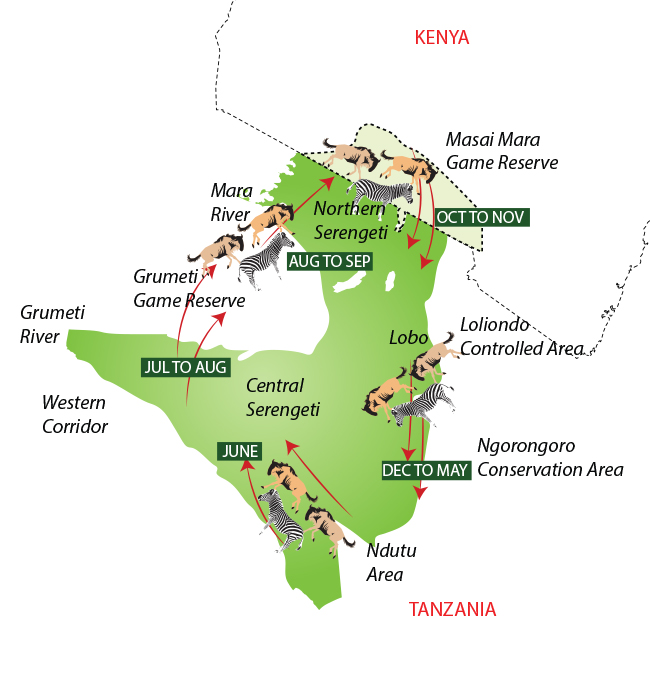Serengeti National Park Map
Serengeti National Park Map, The Serengeti National Park, a UNESCO World Heritage Site, is abundant in wildlife, hosting over 2 million ungulates, 4,000 lions, 1,000 leopards, 550 cheetahs, and more than 500 recorded bird species within its expansive 15,000 square kilometers of endless plains.
Serengeti National Park is renowned as the home of the Great Migration, serving as a sanctuary for the world’s greatest wildlife migration, specifically the yearly wildebeest migration. The park is the sole location where one may observe millions of migrating wildebeests over the Acacia Plains. During the annual migration of wildebeests, approximately 200,000 zebras and 300,000 Thomson’s gazelles accompany more than 1 million wildebeests on a journey of 1,000 kilometers. This three-week trek coincides with the breeding season, resulting in the birth of over 800 calves daily.
Serengeti National Park is a fundamental site for human wildlife interaction and one of the few remaining regions on Earth where one can encounter an unspoiled African wilderness.
Serengeti National Park is the inaugural and most frequented national park in Tanzania.
Map of Serengeti National Park

Geographical location of Serengeti National Park
Serengeti National Park is situated in north-central Tanzania, partially bordering Kenya and northwest of the adjacent Ngorongoro Conservation Area, within the Arusha Region of the Mara Region of Tanzania.
Serengeti National Park is located 255 kilometers from Arusha Town to Naabi Hill, the primary entrance gate to the park. The initial 150 kilometers are paved, while the latter 105 kilometers consist of unpaved roads. The driving duration from Arusha is 5 to 6 hours.
History of Serengeti National Park
The Serengeti National Park was characterized by explorers and missionaries in the late 1800s and early 1900s as the Serengeti plains, notable for its vast populations of wildlife. Prior to the explorations of the late 1920s and early 1930s, scant details were documented about the Serengeti until the initial references to the great wildebeest migrations and the first photographs of the area emerged.
In 1930, an area of 2,286 square kilometers was designated as a game reserve in what is now the southern and eastern Serengeti; sport hunting remained permissible until 1937, when all hunting operations were prohibited.
In 1940, the area was designated a Protected Area, and in 1951, the National Park was founded, encompassing the Southern Serengeti and the Ngorongoro Highlands, with the park’s headquarters situated on the rim of the Ngorongoro Crater. The original Serengeti National Park was established in 1951, which also included the Ngorongoro Conservation Area. In the same year, the Ngorongoro Conservation Area was separated from the Serengeti National Park, and the park’s limits were extended to the Kenya border. The division occurred when the local Maasai residents recognized the imminent prospect of eviction, which prohibited them from grazing their cattle within the national park boundaries.
Concerning Serengeti National Park
Area: 14,763 square kilometers (5,700 square miles)
Location: 2555 kilometers from Arusha, adjacent to Kenya to the north and Lake Victoria to the west.
The Serengeti kopjes are renowned rocky outcrops scattered throughout the plain, providing refuge for numerous species. The most renowned are Simba Kopjes, Moru Kopjes, and Masai Kopjes, which are accessible on the photographic safari.
Directions to Serengeti National Park
Despite its remote location, Serengeti National Park is readily accessible. Most safaris to Serengeti National Park commence from Kilimanjaro International Airport, from where both road and air transportation options are available.
Accessing Serengeti National Park via Air
Numerous domestic and charter airlines provide flights from Kilimanjaro International Airport (JRO) or Arusha Airport (ARK) to one of the seven airstrips located within Serengeti National Park, with flight durations ranging from approximately 1 to 5 hours from Arusha to Serengeti.
Upon arrival at the airstrip, a representative from Gorilla Trekking In Africa or the lodge personnel will greet you and escort you to your accommodation, including an en-route wildlife drive.
Accessing Serengeti National Park via road
The travel from Arusha city to Serengeti National Park takes roughly 8 hours, and it is recommended to utilize a 4×4 vehicle.
